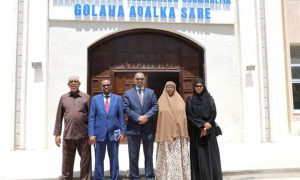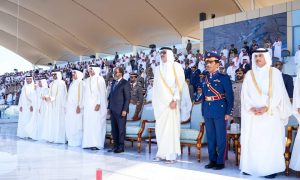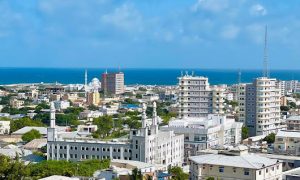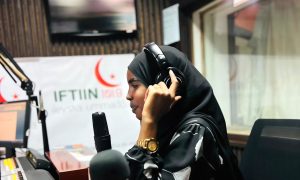
Ghelawdewos Araia, PhD
Tigrai Online December 18, 2014
Muqdisho,23 March 2016:The unification of Ethiopia and Djibouti would be a historical reaffirmation of the genetic linkage of the two peoples. I argue that the peoples of Ethiopia and Djibouti are genetically and historically inextricably linked together, not only to imply that their respective countries are geo-politically intertwined, but also to undergird the common heritage, historical experiences, the oneness of cultural ethos, same language, and linguistic semiotics shared by the two peoples on either side of the Ethiopia-Djibouti border. The two main ethnic groups that make up Djibouti are the Afar and Issa, whose ancestral homes are in Ethiopia. Wherever they may be, all Afar people claim Awsa, Ethiopia as the birthplace of their ancestors. Likewise, all Issa (a Somali clan) strongly believe that their original home is Ugaz (in greater Dire Dawa, Ethiopia).
Due to historical circumstances and superimposed imperial hegemony, the peoples of Ethiopia and Djibouti have gone separate ways and were divided by artificial boundaries, and as a result they evolved discrete national identities. Put otherwise, same ethnic groups found themselves in different nation-states, as it was experienced by many African nationalities, most notably the Fulani and Mandingo of West Africa.
In order to further understand and appreciate the genetic and historical connection of Ethiopians and Djiboutians, however, I like to briefly outline the making and evolution of the two Horn of Africa countries. It was in Hadar, Ethiopia that Denknesh or Lucy was found in 1974 by paleontologists Donald Johanson and Tom Gray. It was also in the same Afar triangle that the 160,000 year-old man or Idaltu (“old man” in the Afar language) was found by a team of UC Berkeley paleontologists, led by Tim White. Our own Berhane Asfaw of the Ethiopian Rift Valley Research Service also found the fossil of a seven-year-old child.
It was also in the same region that the homo sapiens would emerge and populate our planet earth by an ‘out of Africa’ exodus. Eighty thousand years ago, the first group of homo sapiens would walk from present-day Afar/Awash valley region of Ethiopia toward Djibouti and then crossed the Red Sea into Yemen. These early ancestors of humanity did not sail on rafts; they simply walked through the then shallow Red Sea, and once they migrated out of Africa, they never came back to their original homes. But, those who stayed behind would populate the continent under different nomenclature such as eastern Kushitic, central Kushitic, southern Kushitic, Semitic Ethiopian, Egyptian, Beja, Omotic, Berber, and Chadic, a classification that I borrowed from Martin Bernal.
There is no doubt that the great great-grandsons and daughters of Denknesh were hunting and foraging in the Horn of Africa and later some of them had become sedentary agriculturalists and others trans-humans; the former, who were collectively known as Abyssinians or Habesha, would later find centralized state systems and a formidable kingdom and empire known as Askum; the trans-humans, especially the Afar, to this day, continued their pastoral mode of production.
At a time when Aksum became a mighty empire during the reign of Aphilas (circa 270 CE), it conquered Hijaz, which is in present-day Saudi Arabia, and during the reign of Kaleb (first decade and half of the 6thcentury CE), Aksum incorporated Yemen as part of its empire and the Ethiopians were the hegemon on either side of the southern Red Sea. At the southern inland outflanks of Aksum, however, there were other mini-kingdoms or quasi states known as Hadya, Dawaro, Bale, and Ifat, and the latter was located in present-day Djibouti.
The above mini-states were mostly led and administered by sultans, but they were threatened by Aksum and later by the Zagwe Dynasty medieval Ethiopia. However, during the third quarter of the 13th century, when Yekunoamlak restored the Aksumite lineage, the Sultanates had gathered momentum and during the reign of Amdetsion (1314-44), they had become contending forces in the region. By the first half of the 16thcentury, when Galawdewos (1540-59) reigned as king of Ethiopia, Jihad was unleashed unto the Christian kingdom by Ahmed Gragn whose origins is believed to have been from Ifat, then popularly known as Adal.
In the 19th century, and as pointed out above, European imperial hegemony would change the geopolitics of the region forever. Ethiopia would find itself on a very shaky ground but would survive the European colonial onslaught; Djibouti, however, would fall under French hegemony and would become the colony of France.
It is against the above backdrop that we must now examine Ethiopia’s interests in Djibouti during the heyday of the Scramble for Africa (partition of Africa by European powers) and also during the reign of Emperor Haile Selassie. In the first half of the 19th century, the Sultans of Afar and Somali had ruled over the Gulf of Tadjoura (also known as Obock), but they will soon vanish in the face of European colonizers. The French signed treaties with the Sultans in 1883; a year later, the British signed the Hewett or Adwa Treaty with Emperor Yohannes, by which Ethiopia would have control over the Bogos, Massawa, and highland Eritrea. Two decades earlier, the Italians had already bought Assab from the Sultan of Afar. In all these political theater and stratagem, it was Emperor Menelik, who had an interest in Obock that was tricked by the French who initially promised him an access to the sea. On the contrary, beginning 1887, France consolidated over what is to become French Djibouti Territory.
During the reign of Emperor Haile Selassie, although Ethiopia successfully incorporated Eritrea and enjoyed access to the sea through the ports of Massawa and Assab, it still pursued interest in Djibouti. This interest in Djibouti, perhaps emanated from the strategic location of Djibouti, but the idea was inspired by Menelik’s vision of railroad that links Djibouti and Addis Ababa.
In 1959, the Government of Ethiopia signed an agreement with France and “Ethiopia was provided with the privilege to exit its goods through the Port of Djibouti without paying any customs duties. The French Government promised that it would make it easy for the Ethiopian Government to realize its presence in the Port of Djibouti.”1 Moreover the Ethiopian Government of Haile Selassie had embarked on many diplomatic ventures in order to make the Bal-el-Mandeb under the jurisdiction of international waters so that Djibouti would not fall to Arab or Somalia influences after it gained independence. Ethiopia presented this proposal at the Second Law of the Sea Conference in Geneva in 1960. Nevertheless, Ethiopia’s wish did not materialize. In desperation, thus, Ethiopia came up with another proposal, this time presented directly to President De Gaulle when he made an official visit to Ethiopia in 1967. The Emperor asked De Gaulle, “what he intends to do with Djibouti,” and to his delight, De Gaulle replied by saying, “we will conduct a referendum, and if the people want independence, we will leave and if they want to stay with France, we will form a home rule” (i.e. sort of an autonomous Djibouti but with the suzerainty of France).
Ethiopia would not mind Djibouti’s independence, but it preferred “Djibouti’s association with France” in order to ward off Arab influence and Somalia’s irredentist claims. By a twist of historical irony, the people of Djibouti voted in favor of “association with France” in 1958 and 1967. The latter referendum was manipulated and influenced by Ethiopia, and as Seyoum Haregot succinctly puts it, “in the late 1967…the former Ethiopian ambassador to Mogadishu, Ahadu Sabure…was sent as consul general with a rank of ambassador to Djibouti, to coordinate Ethiopia’s efforts in the general referendum. In addition, high-ranking officials with the rank of vice-minister were appointed as governors of the districts contiguous to Djibouti to assist the people in those areas in participating in the referendum. The leaders of the Afar and Issa were mobilized to help this endeavor. Ethiopia’s Afars and Issas were sent across into Djibouti to vote “yes” by the thousands. In case the “no” vote prevailed, Ethiopia prepared a special force to occupy the territory.”2
By 1977, a third referendum was conducted and the overwhelming majority of the people of Djibouti (close to 99%) voted for independence and Hassan Gouled Aptidon was elected as the first president of Djibouti. By this time, Ethiopia was embroiled in the post-1974 Revolution, followed by civil war and Red Terror of the Derg military rule, and the country was completely derailed from its ambitions on Djibouti and its desire to have access to the sea. Moreover, Ethiopia would lose the ports of Massawa and Assab following the independence of Eritrea in 1991/93 and seizure of state power by the Ethiopian Peoples Revolutionary Democratic Front (EPRDF) in the same year.
In the wake of the complicated global scenario of the early 1990s, including the collapse of the Soviet Union, geopolitical and demographic changes in the Horn of Africa (the birth of new nations of Eritrea and Sudan), it is understandable that shifts of alliances and interests would ensue in the region. In the midst of all these, Ethiopia would continue to strive in the quest for port services on the sea. In order to ease the demands of shipments of goods, including Ethiopian products for exports and other products for imports, the country has created a dry port at Modjo, but this inland port would not completely satisfy Ethiopia’s trade transactions, especially now when the country’s economy shows promises and hundreds of international investors have chosen Ethiopia as their favorite venue for trade and partnership. In this context, thus, Djibouti remains a vital sea outlet for Ethiopia.
The unification of Ethiopia and Djibouti in any form (federation, confederation, special economic zone etc) would be a historical achievement for both countries and peoples, both in terms of political stability and economic development.
When I read the news story on the unification of Ethiopia and Djibouti on the Ethiopian Reporter, I was gratified to witness the proposal of unification coming from the Djibouti leadership, and that story has served as inspiration for the writing of this essay. According to the Ethiopian Reporter (Amharic), the current president of Djibouti, Ismail Omar Guelle, is believed to have said, “If it is the wish of the Ethiopian and Djiboutian peoples, we have to translate the unification into action”; “the peoples of Ethiopia and Djibouti were intertwined long before the construction of the railway; the two countries are friends and there is no sector where they have not cooperated; we don’t feel any difference between the peoples of Ethiopia and Djibouti.”3
This is not the first time Mr. Guelle has entertained the idea of his country’s integration with Ethiopia. Back in 1998, when he was the Minister of Defense and Security, in an interview with Efoyta magazine, he said, “The authorities in Djibouti would make every effort to expand the horizon of mutual cooperation and support between Ethiopia and Djibouti to the extent of political, economic and social integration.”4
It seems to me the time is ripe and conducive for the integration of Ethiopia and Djibouti and the reunification of the same people on either side of the border. There may be some lingering Arab interest in Djibouti, but this time, for all practical purposes, it is not going to be to the detriment of Ethiopia’s national interest. Beginning 2011, dramatic political changes took place in North Africa and parts of the Middle East. Following people’s uprisings, Tunisia, Libya, and Egypt witnessed, at least, regime changes short of fundamental structural changes. Iraq and Syria, the erstwhile enemies of Ethiopia, also encountered major political instability, and other Arab countries like Saudi Arabia and the Gulf Emirates have shown interest in investing in Ethiopia, and they seem to have made a departure from their previous negative outlook on Ethiopia.
The above significant changes, by default, have created enormous advantages for Ethiopia and Djibouti in such a way to realize the fruition of their common agenda. On top of this, as pointed out earlier, President Guelle’s vision seems to have echoed the distant past of the genetic and historical connection of the two peoples, and this is not surprising at all. Ismail Omar Guelle, after all was born in Dire Dawa, Ethiopia and he belongs to the Mamassan sub-clan of the Issa. He was actually born in the original home of all Issa, the Ugaz, where his umbilical chord was buried, and driven by his instinct and his intelligence, he wants to come back to the home of his ancestors.
Ethiopia should reciprocate by embracing the Djibouti initiative, not only by connecting Addis Ababa and Djibouti via the new railway, currently under construction, and providing free water supply, but also by furnishing all necessary tools and mechanisms in order to expedite the unification of the two countries. However, while Ethiopia seize the moment of integration, it should be done in stages so as not to falter as in hurriedly and haphazardly done projects. It is also advisable that both countries initiate cultural exchanges and dialogue in order to solidify their good neighborly relations, and ultimately realize an effective vehicle for integration. Moreover, people-to-people relationship must be promoted in the form of student exchange programs; interactive dialogue of women, teachers and professors, union and business leaders, religious leaders and civic leaders, artists, writers and authors, entrepreneurs, and professionals in many fields including medicine, agronomy, and engineering.
The cultural dimension of integration would further promote mutual understanding and trust between the two peoples and also cement their relationships, which, in turn, would pave a smooth road for the political and economic integration.
Finally, it is the two peoples and governments of the two countries that could decide what kind of integration they would like to forge, and in my opinion the Governments of Ethiopia and Djibouti should jointly organize a panel of intellectual experts in the fields of sociology, anthropology, and intercultural communication for the cultural aspect of integration; conflict and conflict resolution to once and for all eradicate differences among the people (as recently was done between the Afar and Somalia regional states of Ethiopia); political science for an in depth analysis, theoretical framework, and policy in regards to the nature and characteristics, as well as structure of the union regime; economics, for micro/macro and overall development agendas; political economy for domestic, regional, and global economy and the would be status and role of the two countries vis-à-vis globalization etc.
For the union of Ethiopia and Djibouti, all it requires is vision, commitment, and will.
_____________________________________________________________________________________
Xafiiska Wararka Qaranimo Online | Mogadishu, Somalia
_____________________________________________________________________________________Advertisement
_____________________________________________________________________________________







